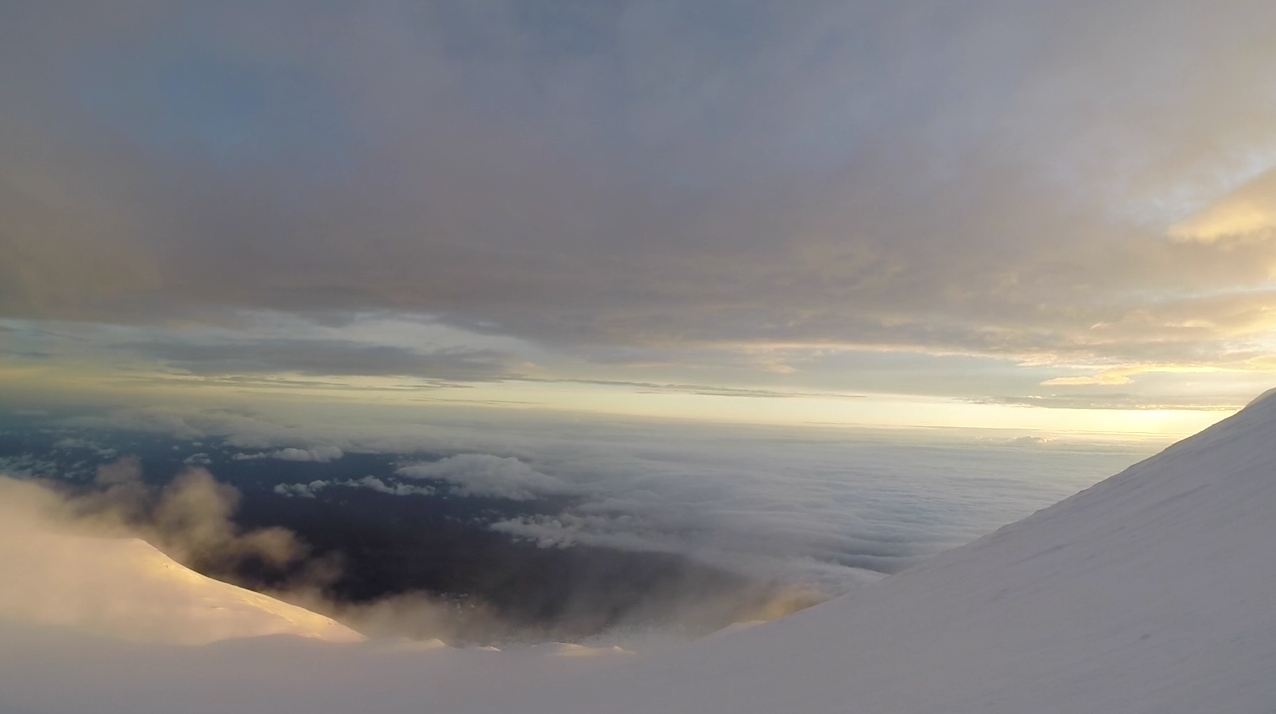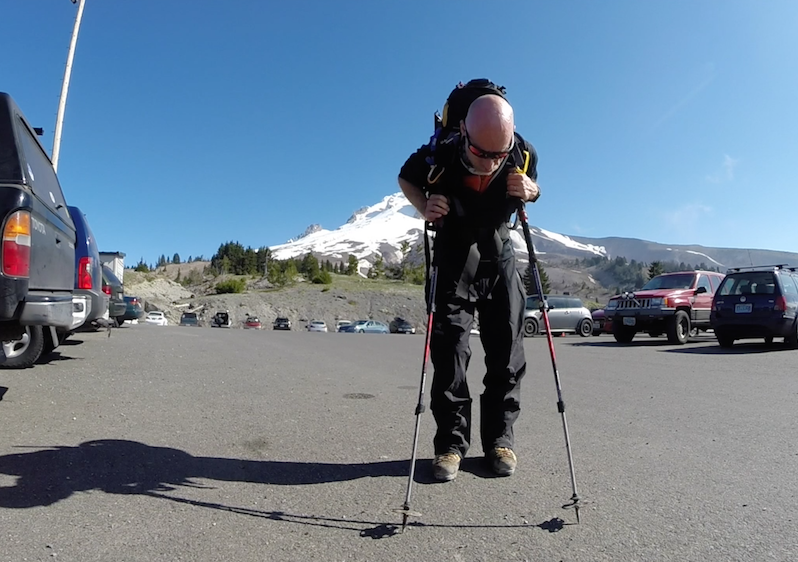Think about these numbers for a moment. 158 miles. 39,764 feet of elevation gain. 64 hours and 48 minutes, from beginning to end.
Who is Christof Teuscher? And how did he climb Mount Adams, run to Mount Hood and then climb Hood – all in one superhuman journey?
When I first heard about Teuscher’s trip, I was skeptical. It seemed implausible for a 42-year-old Portland State University professor even to imagine accomplishing such a feat — much less actually do it.
But once I read his trip report and watched his documentary, I knew Christof Teuscher was for real, and so was his surreally ambitious journey from the summit of one Cascade volcano to another, over the course of nearly three days on Memorial Day weekend. His writing voice was humble and transparent — even self-deprecating at times. And his documentation was completely solid.
He was supported by his wife Ursina, who drove over 150 miles on remote roads to set up at key rest stops where Teuscher refueled, changed his socks and prepared for the punishment ahead. He survived on broth, hot chocolate, a mixture of Pringles potato chips and cookie crumbles, and one major gut bomb of a bacon-and-hash-browns breakfast in Cascade Locks. He slept a total of three hours.
Here’s a photo of him at the end of the journey, with Mount Hood in the background:
Yep, he did it all right. But how? And, um, why?
I spoke with Teuscher on Thursday, June 4, a week and a half after his epic adventure. Here is a transcript of our conversation, edited for brevity:
Where did you grow up?
I grew up in Switzerland, in the mountains.
Running and climbing and skiing – was that part of your family heritage growing up?
Not running, but definitely mountaineering, hiking and skiing. My parents still say that I skied earlier than I actually walked. That was just part of life where I grew up.
When did you come to the United States? And how long have you been with PSU?
I came over in 2004, and I’ve been with PSU since 2008.
You teach and do research? What specifically do you research?
The main research direction we take is looking at computers of the future, how they are going to work, what they are going to be made of, all these things, with the time frame of 10-20 years, beyond what industry looks at. It’s really pushing the limits, and that’s where I see the connection to extreme sports, which are also about pushing the limits and opening up new worlds.
When you’re out there running do you ruminate on the distant future of computers and technology? Is that a good time to think?
It’s a good time to think about all kinds of things. It’s an opportunity to step back and get a different perspective on things. I very often get new ideas and insights while I’m doing something else, like running, or doing crazy adventures.
It seems like you haven’t been into running that long. You must have really gotten the bug.
It’s basically been two full years since I started. I didn’t run for 20 years, mainly because I thought I had a knee injury, which turned out not to be true. Yeah, it just kind of took off. It was just hard work really. It’s just about persistence and motivation and just hanging in. I trained really hard and really consistently, and still do.
‘I was ready for epic failure’
What possessed you to try to climb Adams and Hood back to back, and to run the distance between them?
It started off last year. A friend suggested to me while we were climbing Adams that I could run to St. Helens and climb Mt. St. Helens too. I thought that sounded crazy, but I went home and mapped out the route, and it looked like it might be possible. So I just kind of naively did it, and it was a terrible experience. I wasn’t prepared, I just went out and did it, and it ended up working in that it was a huge adventure. And then I thought, well, if I can do Adams to St. Helens, then what about Adams to Hood? So I mapped out that route, and I realized this was going to be way above anything I’ve ever done. And it was. I was ready for epic failure. I never thought I could pull it off in the first attempt.
It does seem impossible. But you’ve documented your journey well, and you’ve been very honest and transparent in your reporting. Has anyone come out and challenged you, and said it just can’t be done, you couldn’t have done it?
No, not so far. I really hope it will inspire people to do it. I know some folks were thinking of Adams to St. Helens. There are more logistics with that one because of the permits – you’ve got to plan ahead. You can’t just do it spontaneously. Same for Adams to Hood, there’s huge logistics involved. It’s a commitment. But if somebody wants to do it, I hope they will.
What was the worst moment of the journey?
I can think of two. The beginning was really hard. You’re thinking about 150 miles to go, and that’s just mentally really tough. Of course you shouldn’t think about the whole distance. The key is to break it down. But still, the beginning was way harder than I thought it would be. And the other low point was in the second night on Table Mountain. For a moment there I thought I was going down the same way I had come up, and I almost panicked. I was like, ‘No, this can’t happen.’ It was so foggy and dark, with the headlamp I was basically blinded by the light. I just couldn’t see well enough to run, so moving was really hard and required a lot of attention. It would have been possible for me in my state of mind to turn around and basically go down. I really had to stop and focus and check my GPS and make sure I was on the right trail and not going down where I had just come up. Mentally, that was a tough moment, and I began to question myself, whether I could go another 60 miles.
Were you feeling somewhat delirious at that point?
It’s not that you’re losing your mind or delirious, but you do start to question yourself.
What keeps you going at moments like that?
Well, you can’t just give up there (laughs). I mean, you are in the middle of nowhere. You can’t just stop. The only way forward is forward (laughs). It’s a good thing, actually, because if you could bail out at any time, you would probably never finish. The key part in these difficult moments is to keep moving, and realize that every step you take, even if it’s a slow step, even if it’s a painful step, is a step towards your goal. And if you just keep doing that, you will eventually end up where you want to be. There’s some beauty in that.
The worst thing would be to sit down and go to sleep. You would probably wake up hypothermic and in terrible shape. You really want to avoid that kind of situation.
“You’ve got to start somewhere, you’ve got to start something”
It seems like you got a euphoric burst of energy climbing up from the Sandy up to Timberline. What do you think happened there?
I’m not sure. There’s a saying in the ultra running community that you can smell the barn. I could see that I could possibly make it at that point. I was really afraid of that climb up. I thought, ‘What if I don’t do it? What would I do?’ So I was very much afraid of that climb up to Timberline, and then I realized that I was actually in pretty good shape. My legs were holding up. And that just led to a realization that I’m actually moving, and moving at a decent speed. And I’m thinking, ‘How is that possible? Can I really finish this now?’ And that led to me thinking, ‘Wow, Maybe I can do this.’
There’s probably endorphins involved as well, the runner’s high, to an extreme.
In your experience is the runner’s high higher when the challenge is more extreme?
Yes. But it’s both ways. It’s extreme highs but it’s also extreme lows that you’d never get otherwise. And it can be just minutes between the highs and the lows, so you can be in the best mind set possible, complete euphoria, and you feel like a hero, and then a minute after that you struggle and stumble over a root, and you go to a really dark place. It comes and goes like waves. It’s fascinating.
Did you ever get the thought that what you were doing was absurd? Did your predicament ever bring on laughter? Like I con’t believe I’m out here in the middle of nowhere and if I fall down I’m going to die? And then you start laughing?
Oh yeah, that totally happens. I think it’s good. It releases some tension.
The name of your blog is aagaa (forgive my pronunciation). Why did you choose that word and what does it symbolize for you?
You pronounce it Ah-Gah. Aagaa is Swiss German, and it means to start something. To me, that’s very important. You’ve got to start somewhere, you’ve got to start something, without necessarily being sure that you can pull it off. It’s part of that willingness to act. If you go for these big things that are sort of beyond what you think you can pull off, the start is often very important. I think many people don’t start these things because they are too afraid, but if they would start they might actually be successful. Pushing yourself out of your comfort zone is all about that first step you’re taking, that commitment you’re making. Being ready to fail and to learn from failure, so that next time you can do better.
Except you didn’t fail – you made it. How did you celebrate your accomplishment?
With some beer and burgers. And sleep was also a large part of it.
How long does it take you to recover from something like that?
It varies widely, depending on how much sleep you get. Usually I go by feel and get back into running as slowly as needed. I ease back off if something doesn’t feel quite right. I’ve done shorter distances where it took me weeks to recover, but this time I recovered fairly quickly.
To get the full story of Christof Teuscher’s epic journey from the summit of Mt. Adams to the summit of Mt. Hood, check out his blog and his documentary. All photos are courtesy of Christof Teuscher.

Last modified: June 4, 2015



